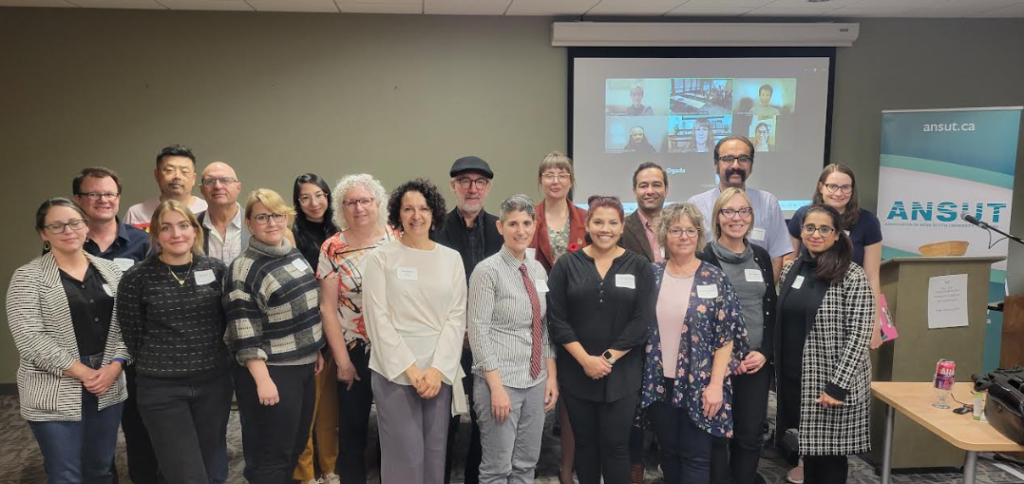By Pouya Morshedi
The Union regularly supports members to be delegates to conferences. Members report back to the Union on what they learned. Pouya Morshedi was CUPE 3912’s delegate to the ANSUT Equity Conference in Fall 2024.
 The meeting started at 9:45 A.M. with Dr. Stewart, the ANSUT president, giving a welcoming speech. It continued with Dr. Jones’s poetry reading. Then, Dr. Brigham provided a report on EDIA activities at different levels at NS universities. They did not mention our union specifically in this report. The recommendation for SMUFU is mentioned below. It may be helpful for our union as well.
The meeting started at 9:45 A.M. with Dr. Stewart, the ANSUT president, giving a welcoming speech. It continued with Dr. Jones’s poetry reading. Then, Dr. Brigham provided a report on EDIA activities at different levels at NS universities. They did not mention our union specifically in this report. The recommendation for SMUFU is mentioned below. It may be helpful for our union as well.
“It would be great to have a compilation of union equity policies and any resources that
unions can use to enhance and support the improvements on EDIA.”
Fabienne Cyrius, the co-chair of the CAUT Equity Committee, gave the keynote speech. She mentioned some useful practices in other universities and some suggestions regarding the EDIA at universities. I mentioned some of them below.
Already have been done in some other universities:
- Course release for members undertaking services tied to identities.
- One university found the role of race and gender of instructors in the way students evaluate them. They decided not to consider these evaluations in instructors’ formal evaluation.
- Plans and protection for part-time faculties to become permanent faculties.
Suggestions:
- Mandatory EDIA training for “ALL” at universities.
- The training could be offered by a committee that includes members from the union and university or only union members.
- A more individual strategy for workplace accommodation.
The panel on Effective Equity Initiative At NS Universities was the next part of the conference. In this part, participants started asking questions and bringing up the issues. I mentioned the precarity of part-time instructors who may stay in this precarity for years without a path to become a permanent faculty member. I also added the language and rules around permanent residency and its relationship to getting a permanent job in Canadian universities, which put more racialized scholars in precarious job situations. It was supported by some other part-time and full-time instructors in the meeting. I believe that we need more presence of part-time instructors at such meetings. However, the precarity and financial situation of part-time instructors make this presence harder. Some of the points brought up by panellists are mentioned below.
- Adding a non-voting equity representative to the hiring committee.
- Having the Equity language in the bargaining process.
- A participant suggested using the term “Equity-denied” instead of “Equity-Deserving.”
Dr. Patti Doyle Bedwell was the next speaker to discuss the Erasures: The Colonialization of Indigenous Identity. She mentioned the issues she faced and how some people in power consider “Diversity means Unqualified” in their discussions and decision-making. She also discussed the issue of pretentious people in academia who try to take advantage of Indigenous positions and accommodation.
Dr. Kubota was the last speaker who discussed the intersectional injustice of race and language. She brought up the hidden forms of prejudice and discrimination that are based on the linguistic profiling. Dr. Kubota addressed language equity and the necessity of considering it in the EDIA discussions.
The conferences ended with a group activity about what was missed and what could be the next step for equity at NS universities. The conference ended at 4 P.M.
 Pouya Morshedi (Ph.D. Cand.). has been teaching in the Sociology Department at Saint Mary’s University since Fall 2020. He’s a co-organizer of The Qualitative Analysis Conference; Chair of The Anti-Racism, Representation, and Diversity Committee at the Society for the Study of Symbolic Interaction (SSSI); and Co-founder of Avalon Research Society He is a qualitative researcher specializing in the sociology of space and place, the sociology of cinema, and the sociology of revolution. He recently published a peer-reviewed article: Home in Cinema and Women at Home: A Comparative Study of Pre- and Post-Revolutionary Iranian Cinema from 1969 to 1999
Pouya Morshedi (Ph.D. Cand.). has been teaching in the Sociology Department at Saint Mary’s University since Fall 2020. He’s a co-organizer of The Qualitative Analysis Conference; Chair of The Anti-Racism, Representation, and Diversity Committee at the Society for the Study of Symbolic Interaction (SSSI); and Co-founder of Avalon Research Society He is a qualitative researcher specializing in the sociology of space and place, the sociology of cinema, and the sociology of revolution. He recently published a peer-reviewed article: Home in Cinema and Women at Home: A Comparative Study of Pre- and Post-Revolutionary Iranian Cinema from 1969 to 1999